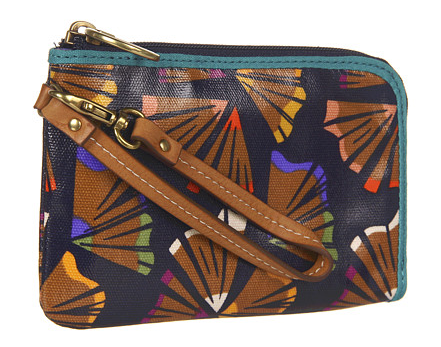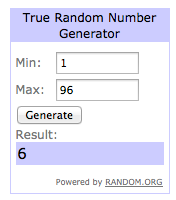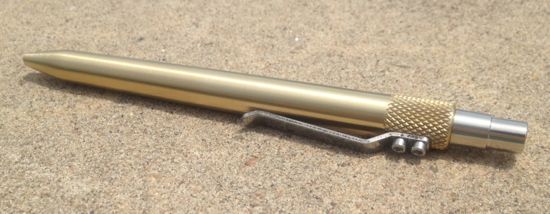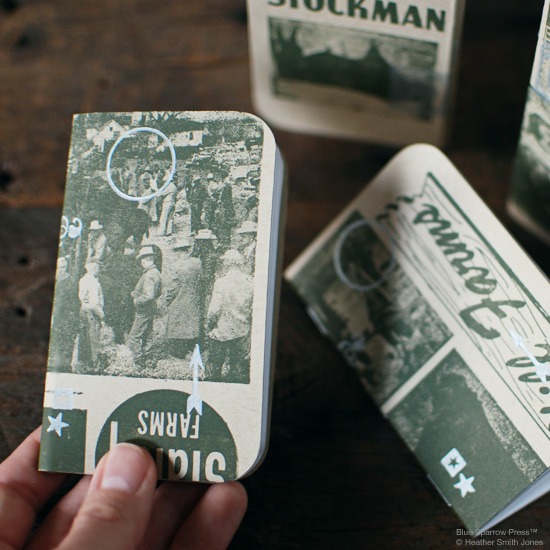Heather Smith Jones has created a collection of pocket-sized Stockman notebooks letterpress printed with array of vintage farming images. There are four different designs and contain 40 pages. Each book is a petite 2 5/8″ x 4 1/4″ — perfect for pocket or purse. $5 each.
Link Love: Inks, RETRAKT and general pen love

The BIG NEWS:
- If you are interested in the Karas Kustoms RETRAKT project on Kickstarter, check out the Karas Kustoms blog , Clicky Post and From the Pen Cup or my short write-up and goofy video.
- Brad over at Pen Addict tries a vintage Esterbrook LJ with 9284 stub nib.
- Johnny at Pencil Revolution reviews the Deflect-o organizer system and waxes poetic about a vintage Bostitch hand stapler Model B8. The photos are fabulous!
Pens:
- UniBall RT 0.28 and Uni ProMark Highlighter Review (Pen Addict)
- Pentel Tradio Energel (via Clicky Post)
- Rhodia Pencil Review (A Penchant for Paper)
- Bamboo Style Fountain Pen by Ken Cavers (via From the Pen Cup)
- Hero 616 Review (via Ink of Me Fondly)
- Pocket-sized pen pals (via My Pen Needs Ink)
Inks:
- Noodlers Bad Belted Kingfisher (East West Everywhere)
- Cult Pens Deep Dark Blue (Pen Addict)
- Organics Studio Edgar Allen Poe (via Inkdependence)
- Pelikan Edelstein Amber (via East West Everywhere)
- Diaminie Denim (via Ed Jelley)
- Pilot Iroshizuku Ku-Jaku (via Ed Jelley)
- Platinum Brown (Fountain Pen Quest)

Paper:
- Doane Paper Products Review (via ClickyPost)
- Tomoe River Paper Review (via Ed Jelley)
Other link lists:
- June Carnival of Pen, Pencil and Paper (via Ed Jelley)
- Sunday Notes and Links (via Fountain Pen Quest)
A Ladies EDC

Men have the advantage of having pockets in just about every garment they wear. Their trousers have pockets; be they jeans, chinos or cargo shorts (extra capacity!). Their shirts have pockets, and sometimes even their t-shirts have pockets. But we ladies face the challenge of where to put our phone, cash, cards and keys. Most women’s clothing do not have pockets and, even the items that should like jeans have these ridiculously small pockets that are almost there solely for looks. “Fashion industry, I’m talking to you! Its time to put pockets and useful additions into women’s clothes while still making them stylish!”
So sure, we can lug handbags, totes bags and briefcases with us everywhere we go, but sometimes, the need arises for a slimmed down solution.
Enter the wristlet. It is a small “portable pocket” large enough to hold those items you need for a jaunt to the grocery store, a trip to Chipotle or just around your enormous (corporate) campus. The solution for a lady’s everyday carry (EDC).
I found the Fossil Key-Per wristlet with pencil shavings pattern on Zappos for $35. It is large enough to hold the average smartphone, has pockets inside to keep ID and credit cards and a gusset on the side to keep coins and loose items from falling out. A short pen like a Fisher Space Pen or Kaweco Sport would also fit. There are other wristlets available on the Fossil site and of course other brand make other options. My co-workers carry a Kate Spade, Coach and BlueQ zippered pouch which range in price from around $10 to well over $100 at retail so there are lots of options to suit your tastes and your budget.

Floral Bomb Winner Announced!
The last of the seven giveaway is here at last. Lots of lovely flowers here this time of year inspired this grouping.
The winning number: 
Congratulations, Suzanne!

I’ll be contacting you via email to make arrangements. And thanks to everyone who entered the drawings this past week. I hope everyone had fun!
Kickstarter: RETRAKT

Karas Kustoms has launched their latest Kickstarter project, the RETRAKT. It is a retractable pen, hand-machined from metal that takes standard Pilot G2 refills. Like their earlier projects the Render K and the Bolt, the RETRAKT is an incredibly crafted piece. The folks at Karas Kustoms sent me the amazing brass edition of the RETRAKT. Its a weighty piece at over 60gms but I’ve been assured that the aluminum models weighs in similarly to the aluminum Render K models (about half that). My favorite part is the absolutely whisper-quiet retracting mechanism. Just click, click, click through a whole meeting without annoying your co-workers.
I made a little video to show off the smooth silent motion of the retractability. It was so quiet I had to add some music (my apologies to Brian Setzer).
You cannot see the seam in this pen where the refills go (tip, its just below the clip). That is craftsmanship! I filled mine with a Pilot Juice refill, because I could but it holds a G2 and several other similar shaped refills.
There are 45 days left in the funding drive on Kickstarter but at Day One, Karas Kustoms has already met their goal. The aluminum model is available at the $40 contribution level and a brass model like mine is available at the $60 contribution level. There is also a copper model available over the $90 contribution level. If you’d like to get in on the ground floor of this amazing pen, support the drive today and get your pen before the holidays.
Review: Staedtler Ink Refill Cartridges
It had never occurred to me to look for interesting ink cartridges at the local office supply store. Until now… I happened to glance across the aisle at my nearest Office Depot to discover that they stock various pen refills (lots of Parker-style refills, FYI) and noticed all the way at the bottom of the shelf was a 12-pack of colored ink cartrdiges from Staedtler in the oh-so-familiar European short cartridge size. $2.69, you say? Don’t mind if I do!
I was surprised to see yellow and orange cartridges but no red or purple. If I were to make a color sample pack of cartridges, I would have skipped blue which is common enough to find elsewhere and probably would have replaced it with purple. My instinct is that the yellow would be hard to use and would swap it out for a red instead. But, hey, Staedtler didn’t ask me and at $2.69 for a dozen cartridges, I’ll take my chances.
So, I hopped home with my purchase and found six fountain pens that all accepted the standard short cartridges (thank you, stash of Kawecos!) to see how they worked.
Carefully reading the back of the package guaranteed that all the colors were standard dye-based, water-based inks so I felt safe to load them into my pens. The yellow was far more usable than I expected, more of a yellow-orange. The orange color has lots of shading but its not as vibrant as I hoped it would be. The pink was a very watery color — it seemed to spread even more than any of the other colors. I switched the color from the Muji with the medium nib to a finer nib Kaweco and it was still squishy and runny. The blue, green and brown were all fine colors. The green has a bit of shading as well and is a nice kelly green, a hair on the blue side. The brown is a dark brown, almost a walnutty brown-black. So, of the six colors, three are solid usable colors. I don’t mind the orange and the yellow was a fun color to have to play with.
The only true dud is the pink. It was just too runny. It might work great in a very fine, very dry pen. I might try it in my EF Prera just to see.
Office Depot does not sell the ink refill pack online but JetPens does. For $3.50 per pack. Worth a try if you like to keep some European short cartridges around for quick refill needs.
Black and White Winner and Loads of Links!
We have almost come to the end of the week of giveaways. My office is looking much tidier now that I’ve boxed up all these extraneous office supplies which will give me room to search for more goodies.
So, the winning number for the black and white giveaway is:

And that coincides with this comment:

Congrats Zee!! I’ll be contacting you by email today to arrange delivery.
Thanks to everyone who entered and left lots of great sites to shop and read.
Here are some of the sites mentioned frequently:
A cherry on top
A Penchant For Paper
Apartment Therapy
Black Cover
Bleistift
Clickypost
Contrapuntalism
Cult Pens
D*I*Y Planner
Design Sponge
Doane
Economy Pens
EdJelley
Fahrneys
Field Notes
FPGeeks
FPN
From the Pen Cup
Goulet Pens (and their blog Ink Nouveau)
Gourmet Pens
houzz.com
Inkophile
Jenny’s Sketchbook
Jetpens (and their blog)
JustDaveyB
kawaiishopjapan.com
Lady Dandelion
Leigh Reyes: My Life As A Verb
Leo Babuta’s Zen Habits
Lexikaliker
Lung Sketching Scrolls
Missive Maven
Moleskine.com
No Pen Intended
Notebook Stories
Notebookism
Office Supply Geek
Okami-whatever
Paper Crave
Paper Lovestory
Paper Source
Pencil Revolution
Pencil Talk
Pencils.com
Peninkcillin
Pentulant
Philofaxy
Pocket Blonde
Rants of The Archer
Recording Thoughts
Rhodia Drive
Richard Binder
Scription
See Jane Work
Sharing Our Notebooks
Spiritual Evolution Of The Bean
Stationery Review
stationerylove and thestationeryaddict on Tumblr
Storage Geek on tumblr
The Five Cat PENagerie
The Pen Addict (of course, and 5by5)
The Writing Desk
Went Sketching
Writers Bloc
Writing by Hand
Writing Through Life
Phew! That was a lot of links. I may have missed a few sites unintentionally since several sites were mentioned multiple times. I hope you find a new source of inspiration from this epic list!





